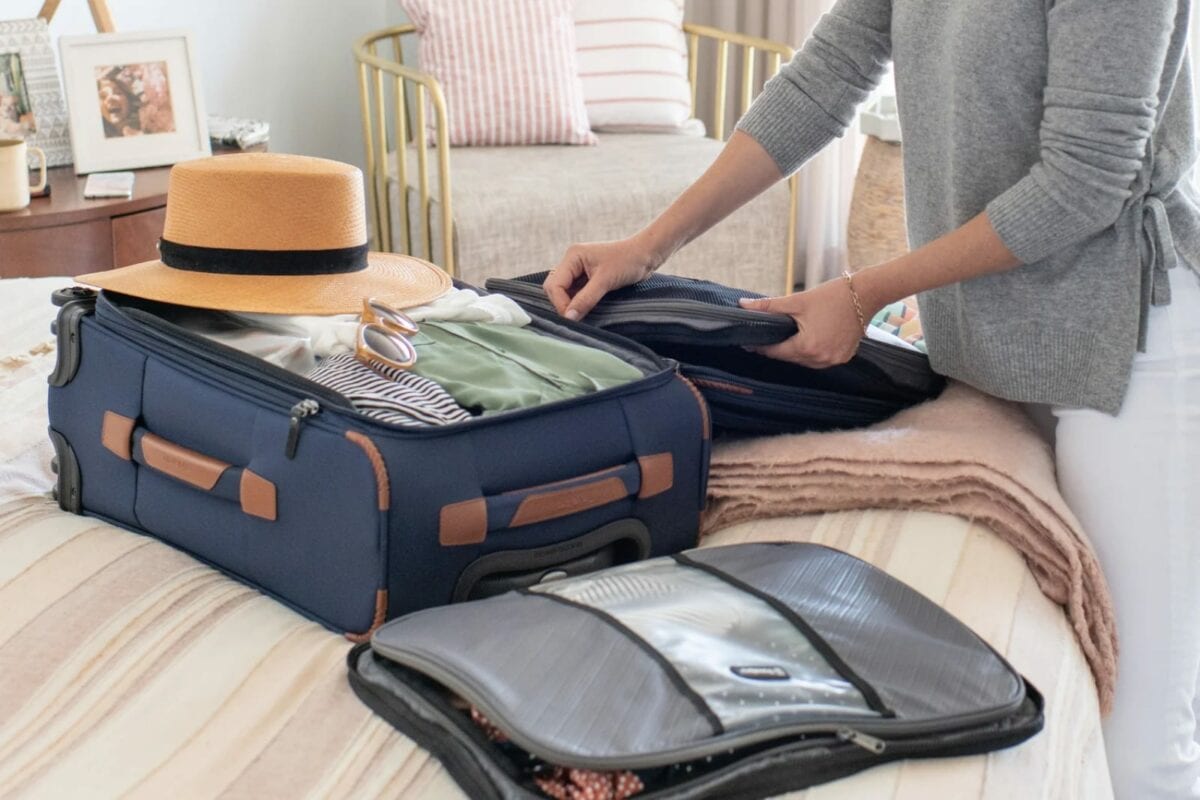Using packing cubes, stuffing socks inside your shoes, and simply bringing less stuff are a few of the packing techniques get the most out of the space in your suitcase.
How to Pack a Suitcase: Efficient Packing Tips for Your Next Trip
So you’ve got an amazing trip planned (hooray!), but now you’re staring at a big pile of clothes and a suitcase that now looks a bit small and wondering how you’re going to fit it all.
I’ve been there. From packing for a three-week business trip in a 26-liter backpack to packing a duffel bag light enough to haul it into the Himalayas, I’ve dealt with some serious packing challenges. And I’ve learned a lot along the way.
Learning how to pack a suitcase for a big trip (or even a small trip) can feel intimidating, but fortunately, there are some easy packing tips that will help you along the way.
I’ll walk you through how to pack everything from socks to wine bottles, and the top packing tips for maximizing space in your suitcase. It’s a bit like a game of Tetris, and after you’ve done it a few times, packing your suitcase to take the absolute best advantage of your available storage space can become a fun challenge.
So what are you waiting for? Grab your suitcase, and let’s get packing!
How to Pack Clothes in a Suitcase
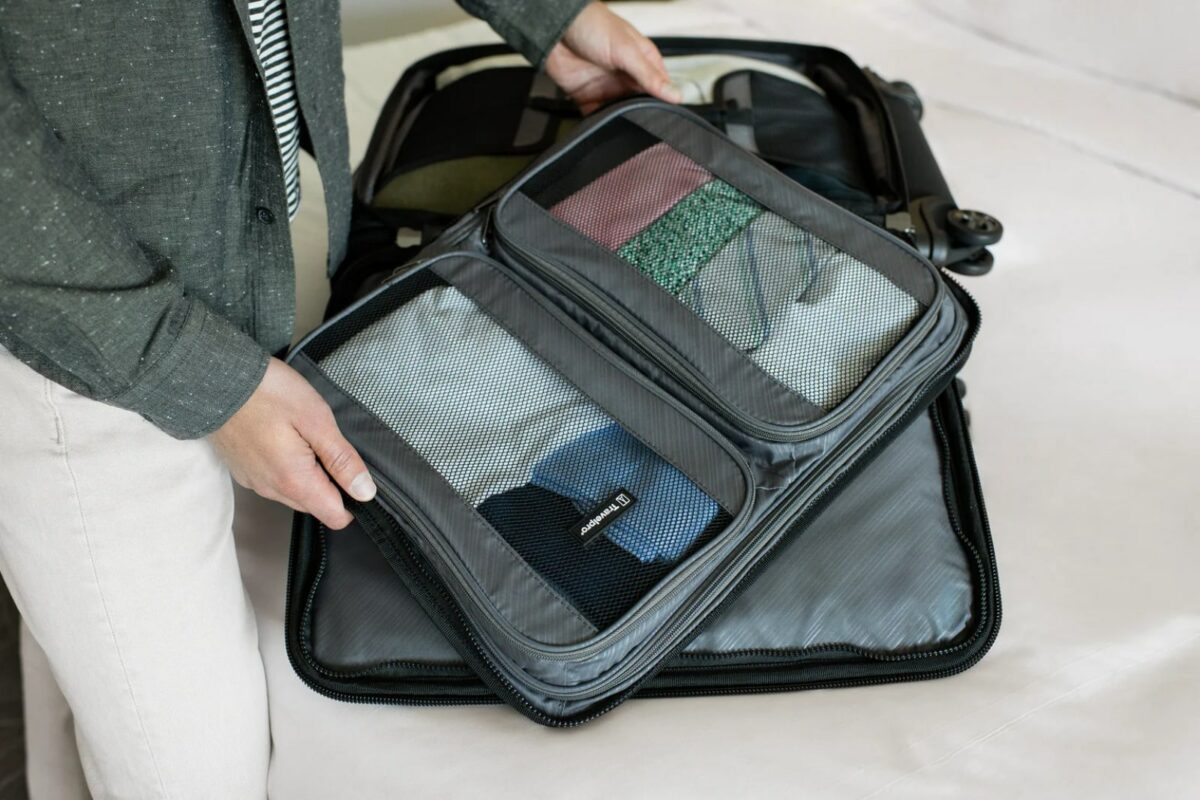
The bulk of your suitcase will be filled with clothing (unless you’re smuggling weapons, of course). It’s super important to pack your suitcase to maximize space for clothing so you can fit everything in. Here are some of the top tips to make the most of your suitcase space.
Pack Only Essential Clothes
The most common problem is overpacking. Of course, smart packing tips can help you to maximize space inside your suitcase, but ultimately there is a limited volume. Unless you’re Mary Poppins, there’s no way to fit everything in your bag.
The standard guidance you’ll hear for a weeklong trip is to follow the 5, 4, 3, 2, 1 rule (5 pairs of socks and underwear, 4 tops, 3 bottoms, 2 pairs of shoes, 1 hat). I’ve found that works as a good starting point for trips of any length. It should get you through a seven-day trip, and if you’re staying for longer, you get to find the local laundromat.
Know When to Roll and When to Fold
Rolling clothes save space in your suitcase and make it easy to fill every little nook and cranny, but it can also lead to badly wrinkled clothes.
The trick is to mix and match the rolling method with normal folding. Soft items like underwear, t-shirts, and cotton pants can be rolled easily and won’t get too wrinkly. Stiffer items like button-ups, more formal dresses, slacks, and blazers should be folded.
Divide and Conquer With Packing Cubes
I don’t like too much chaos, and it seems like that’s what you always end up with after a few days of travel: a big, jumbled mess in your suitcase. Packing cubes are a fantastic way to tame the chaos and keep everything neat and organized.
I highly recommend you get a set of packing cubes in different sizes if you are traveling frequently. Then you can dedicate each one for a specific purpose: one for socks and underwear, one for shirts and pants, etc.
Not only does this help organize items, but it can also save space by compressing clothes down into manageable packages.
Some of my favorites are the Eagle Creek Pack-It Reveal Cubes. They are lightweight and open fully. Plus, each packing cube has a mesh panel so you can easily see what’s inside.
Packing cubes for the win!
Wear Bulky Items
If you’re traveling in winter and need to bring cold-weather clothing, wearing bulky items like jackets on the airplane can save space by keeping them out of your bag. Airplanes tend to be cold anyway.
How to Pack Shoes in a Suitcase
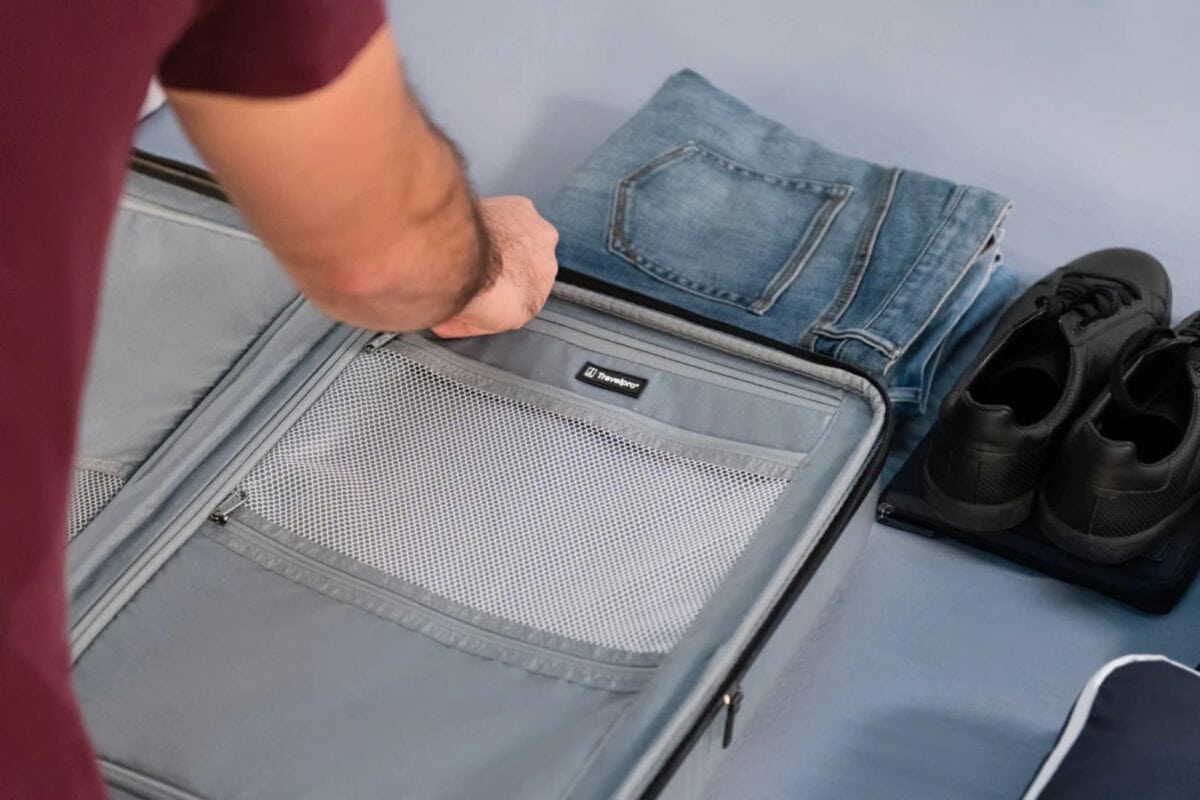
Let’s face it, shoes are shaped really weird. They’re bulky, heavy, and it’s hard to figure out how to pack them. Here are some of my top tips for packing shoes:
Don’t Bring Too Many Pairs
Do you really need five pairs of shoes? Really?
I’ve said it before, and I’ll say it again: the most important thing when you’re trying to pack your suitcase to maximize space is learning what to leave behind. Especially if you’re traveling with just a carry-on bag, there’s just not a lot of room to spare.
For most trips, you can very likely get by with two pairs of shoes (or even one). I would recommend trying to never take more than three unless you really need to: one pair of sandals, one pair of nicer-looking/dress shoes, and one pair of casual/athletic/walking shoes.
Stuff Other Things Inside
Don’t waste the valuable extra space inside your shoes! I like to fill that volume with socks. Not only does it help maximize space, but it will also keep your shoes from being crushed out of shape.
Use a Shoe Bag
To keep your clothes and other items clean, I recommend using a dedicated bag to keep your clothes separate. This can be a simple trash bag or some extra packing cubes.
Pack Them in the Corner
I like to place shoes in the very bottom corner of my suitcase. I put the soles either toward the bottom or the sides, and have the heel face the wheels. This helps save luggage space and keep everything neat.
How to Pack Toiletries
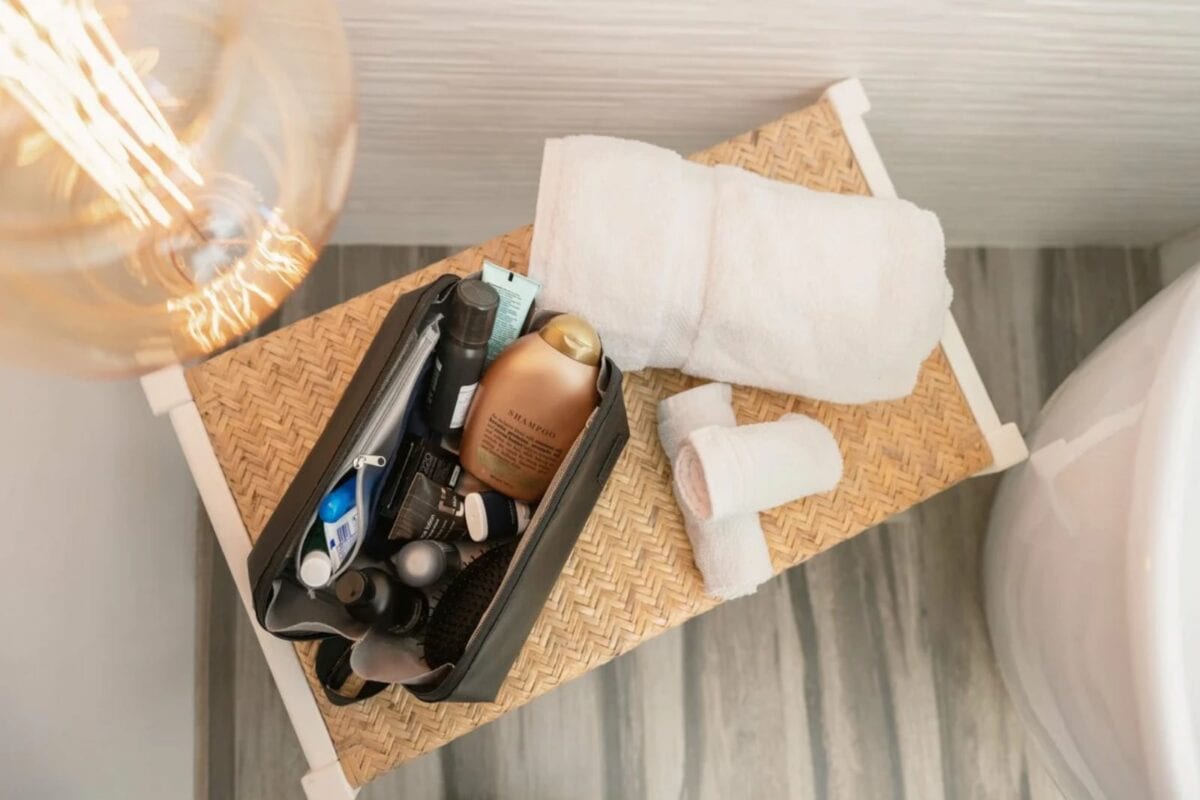
One of the worst experiences I’ve had was when a toothpaste tube exploded all over my clothes on a trip. Okay, maybe I’ve had worse experiences, but it was no fun.
Here are the best ways to pack your toiletries and liquids while traveling.
Use Plastic Bags for Liquids
The standard method for packing liquids like shaving creams, lotions, soaps, and more is to have a dedicated plastic bag. Not only does this prevent leaks from getting all over, but it makes it easy to pull out your liquids if you need to for TSA scanning. For that reason, you should keep your liquids bag easily accessible.
I recommend using one of those bags with the sliding zipper lock, they’re just a bit more secure than normal Ziploc bags.
Use a Toiletry Bag for Other Items
I like to have a small zippered toiletry bag for the rest of my bathroom kit. The Monos Metro Toiletry Case is compact, simple, and very easy to use. There are tons of functional options out there though that will get the job done.
How to Pack Dirty Laundry
All those clothes you pack will end up turning into, you guessed it, dirty clothes (amazing how this stuff works). Rather than just tossing it all straight back in your suitcase, I recommend having a system to keep dirties separate from everything else so your bag doesn’t get too funky.
It’s pretty easy to use a drawstring trash bag or a water- and odor-resistant fabric stuff sack to store your laundry and keep it separated from everything else. Throw all your clothes in there at your hotel room, and toss the bag in your carry-on when it’s time to go.
How to Pack a Suit or Dress in a Suitcase
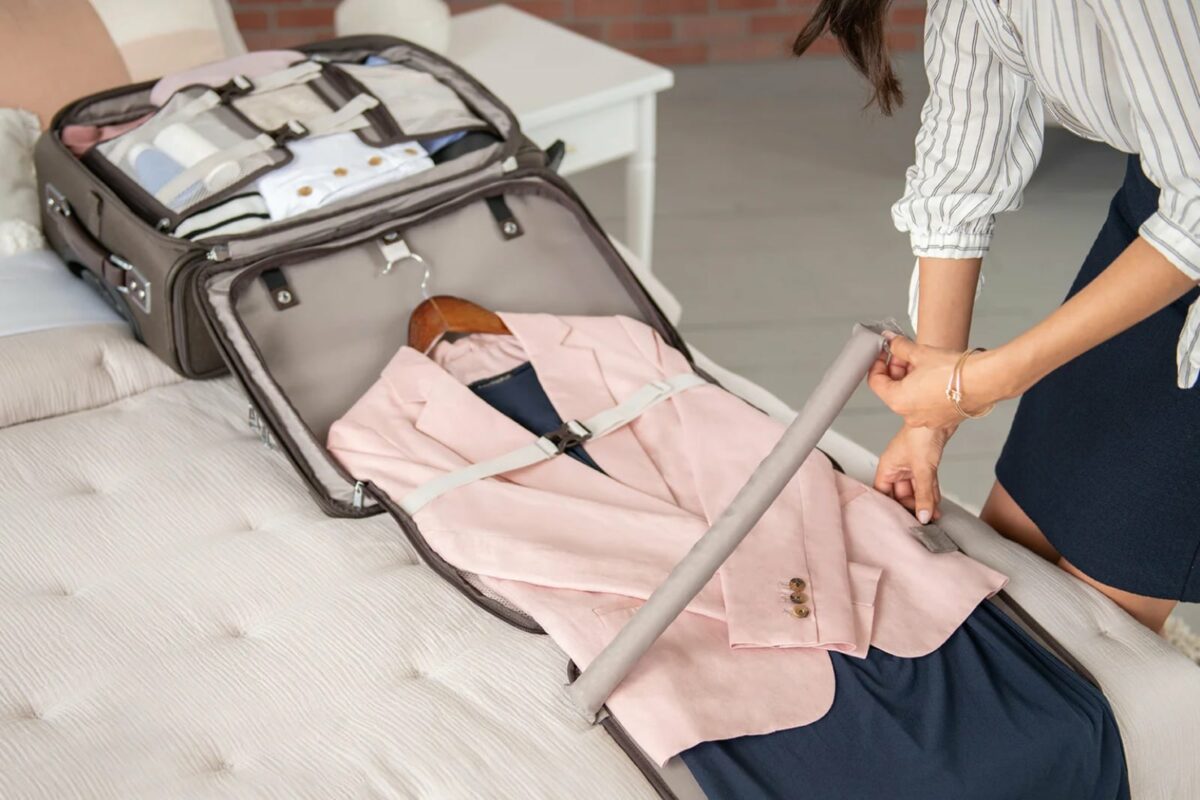
The best way to pack a suit, dress, or other formal clothing is to use a dedicated garment bag. Garment bags are great for packing your formal clothing by either hanging them in a closet or laying them flat, and then folding them up while holding everything in place to prevent wrinkles.
If you don’t have a garment bag, you can still pack your suit or dress neatly to minimize wrinkling. There are all sorts of complicated folding methods out there, but those are time-consuming and hard to remember. Here’s the simpler method I’ve found works best:
Step 1: Keep It on the Hanger
If you keep your suit or dress on its hanger, it will keep its shape better, and you’ll reduce the risk of crumpling it. Plus, it makes it easier to pack and unpack.
If you have a pair of suit pants, just drape them over the bottom bar of the clothes hanger.
Step 2: Pack It in First
Before adding any of your other clothes, place the suit or dress in the bottom of the suitcase. Let the long end drape over the side. In checked luggage you can probably orient the garment with the hanger at the top, but for a carry-on bag you may need to pack it in sideways.
Step 3: Then Pack Everything Else
With the end of your suit or dress still hanging over the outside of the case, start packing everything else in. You can use all the other tips for saving space here: packing cubes, rolling clothes, stuffing shoes, etc.
Step 4: Fold the Ends Over
Once everything else is in, take that end that’s hanging over the edge and fold it over the top of everything else.
This method lets you pack efficiently, maximize space, and prevent wrinkles in your fanciest clothing items.
How to Pack Fragile Items in a Suitcase
One of the trickiest things is how to pack fragile items so they don’t break. Whether you’re bringing a few bottles of wine or are taking home a pottery vase you bought as a souvenir, packing breakables can be stressful.
Pack Them in Your Carry-On Luggage
If you’ve ever watched airline baggage handlers tossing checked luggage into an airplane’s cargo hold, you’ll wince at the idea of putting anything fragile in your checked bag. Seriously, those guys don’t go easy on checked bags.
The better choice is to put any breakable items in your carry-on. That way you’re in control and can make sure there isn’t too much rough and tumble.
Use Clothes as Padding
Wrap any fragile items with clothing as padding and protection. Thicker, softer clothes like sweaters and jackets work really well.
Use a Hardside Suitcase
This might not be an option if you already own softside luggage, but hardside suitcases offer the best protection from bumps and impacts for breakables. If you’re shopping for a suitcase and know you’ll be traveling with fragile items a lot, a hard shell may be the best choice.
Other Considerations When Packing a Suitcase
We’ve covered the basics, so here are a few last tips to help you pack your suitcase efficiently and avoid unnecessary headaches.
Make a Packing List
You don’t want to forget anything on your trip, and the best way to avoid that is to make a comprehensive packing list of everything you need to bring. Start making your packing list well in advance so you have time to think of all those easy-to-forget items.
Don’t Forget the Weight Limit
We’ve talked a lot about making the most of the space in your suitcase, but weight is also a concern because airlines have weight restrictions for luggage. You can typically bring a bag that’s over the weight limit, but you’ll pay some hefty fees for it.
Airline weight restrictions are typically 50 lbs for a checked bag, 35 lbs for domestic carry-on bags, and 15-25 lbs for international carry-ons.
Practice Packing
If you want to avoid packing stress, I recommend you practice packing your suitcase beforehand rather than trying to cram everything in the night before a trip. Try a few different methods and get a feel for how much stuff you can fit. That way, when it’s time to do the real packing, you’ll already have an idea of what to do.
How to Pack a Suitcase FAQs
-
What is the 5 4 3 2 1 packing method?
This rule says you pack 5 pairs of socks and underwear, 4 tops, 3 bottoms, 2 pairs of shoes, 1 hat.
-
How do you pack a suitcase to maximize space?
Some ways to save space are to roll clothes, stuff socks inside shoes, and pack shoes in the corner.
-
Is it better to roll or fold clothes when packing a suitcase?
You should roll softer clothes like t-shirts and underwear and fold starched clothes.
-
How do you organize outfits in a suitcase?
Pack the last outfit you’ll wear first and your first outfit on top so you can get to them in order.
-
How do you roll clothes for packing a suitcase?
Fold shirts in half, then roll from the bottom up. Fold pants in half and roll from the waist down.
